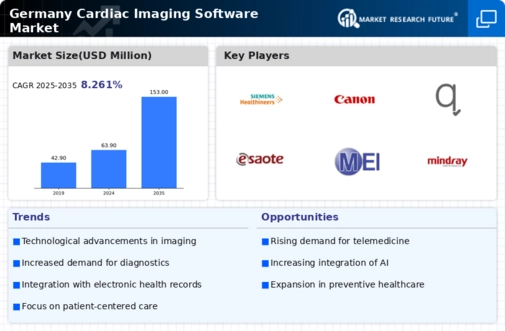Government Initiatives and Funding
Government initiatives aimed at improving healthcare infrastructure in Germany are significantly influencing the cardiac imaging-software market. The German government has allocated substantial funding to enhance medical technology and digital health solutions, with an emphasis on improving diagnostic capabilities. For instance, the Digital Healthcare Act encourages the adoption of digital health applications, including imaging software, in clinical practice. This legislative support is expected to drive investments in cardiac imaging technologies, fostering innovation and accessibility. Additionally, public health campaigns aimed at raising awareness about cardiovascular health are likely to increase the demand for advanced imaging solutions. As a result, the cardiac imaging-software market is poised for growth, supported by favorable government policies and financial backing.
Rising Demand for Personalized Medicine
The shift towards personalized medicine is reshaping the landscape of the cardiac imaging-software market. As healthcare providers increasingly focus on tailored treatment plans, the need for precise diagnostic tools becomes paramount. In Germany, the emphasis on individualized patient care is driving the adoption of advanced imaging technologies that can provide detailed insights into a patient's unique cardiac profile. This trend is further supported by the growing body of research linking specific imaging findings to targeted therapies. Consequently, the cardiac imaging-software market is likely to experience growth as healthcare professionals seek software solutions that facilitate personalized diagnostics and treatment strategies. The integration of genetic and imaging data may also enhance the effectiveness of cardiac care, underscoring the importance of innovative software in this evolving paradigm.
Expansion of Healthcare Facilities and Services
The expansion of healthcare facilities and services in Germany is a crucial driver for the cardiac imaging-software market. As new hospitals and specialized cardiac centers emerge, the demand for advanced imaging solutions is expected to rise. Recent reports indicate that the number of cardiac care facilities in Germany has increased by approximately 15% over the past five years, reflecting a growing commitment to addressing cardiovascular health. This expansion necessitates the implementation of efficient imaging software to support diagnostic processes and improve patient management. Additionally, the trend towards integrated care models, which emphasize collaboration among healthcare providers, further amplifies the need for interoperable imaging solutions. As a result, the cardiac imaging-software market is likely to benefit from this expansion, as healthcare systems invest in technologies that enhance service delivery and patient outcomes.
Increasing Prevalence of Cardiovascular Diseases
The rising incidence of cardiovascular diseases in Germany is a primary driver for the cardiac imaging-software market. According to health statistics, cardiovascular diseases account for approximately 40% of all deaths in the country. This alarming trend necessitates advanced diagnostic tools, including cardiac imaging software, to enhance early detection and treatment. As healthcare providers seek to improve patient outcomes, the demand for sophisticated imaging solutions is likely to grow. Furthermore, the aging population in Germany, which is projected to reach 23 million individuals aged 65 and older by 2030, further exacerbates the need for effective cardiac care. Consequently, the cardiac imaging-software market is positioned to expand significantly as healthcare systems adapt to these demographic changes and the associated healthcare challenges.
Technological Advancements in Imaging Techniques
Technological innovations in imaging modalities, such as MRI and CT scans, are propelling the cardiac imaging-software market forward. The introduction of high-resolution imaging and 3D visualization capabilities enhances diagnostic accuracy, allowing for better assessment of cardiac conditions. In Germany, the market for advanced imaging technologies is expected to grow at a CAGR of around 8% over the next five years. These advancements not only improve the quality of care but also streamline workflows in healthcare facilities. As hospitals and clinics invest in state-of-the-art imaging systems, the demand for compatible software solutions that can process and analyze complex imaging data is likely to increase. This trend indicates a robust growth trajectory for the cardiac imaging-software market as it aligns with the evolving needs of healthcare providers.


















Leave a Comment